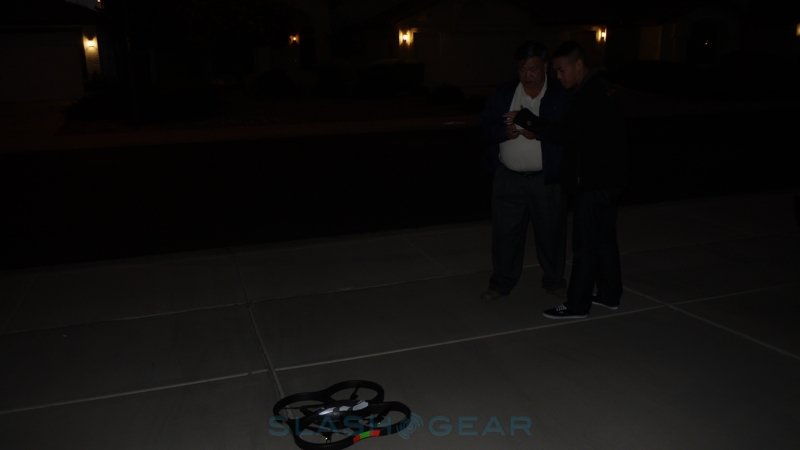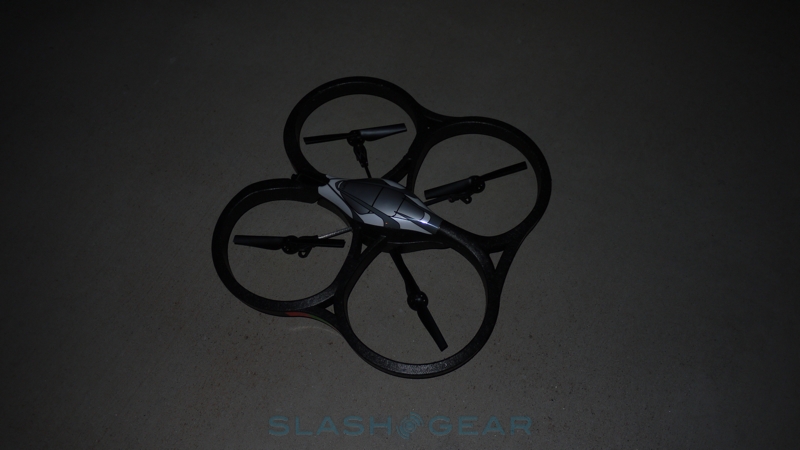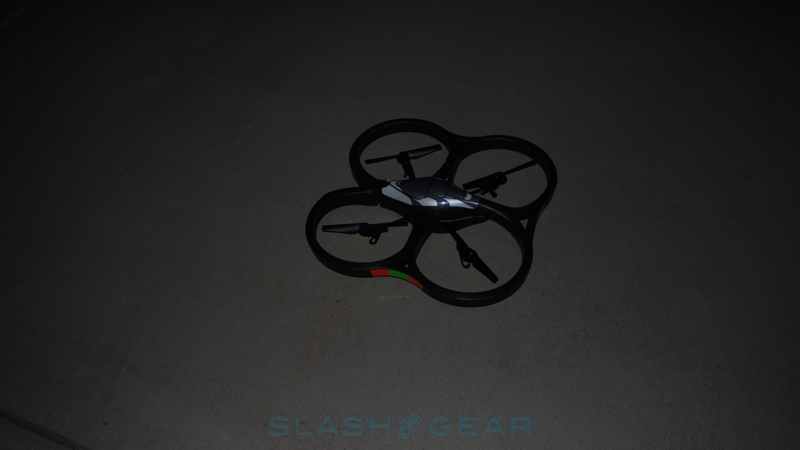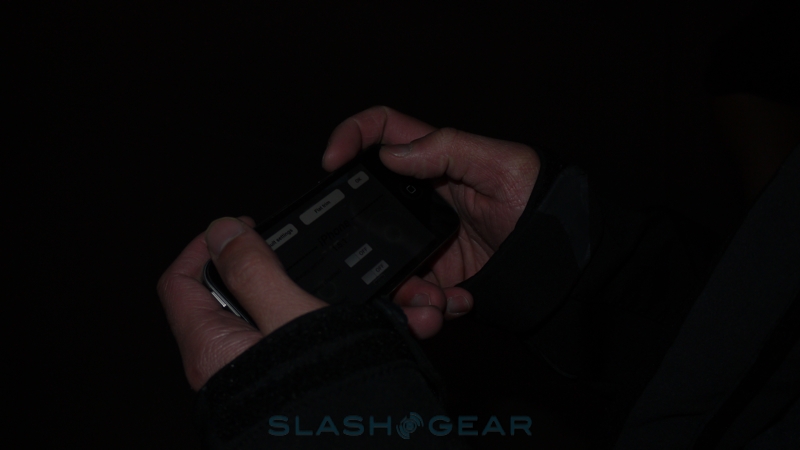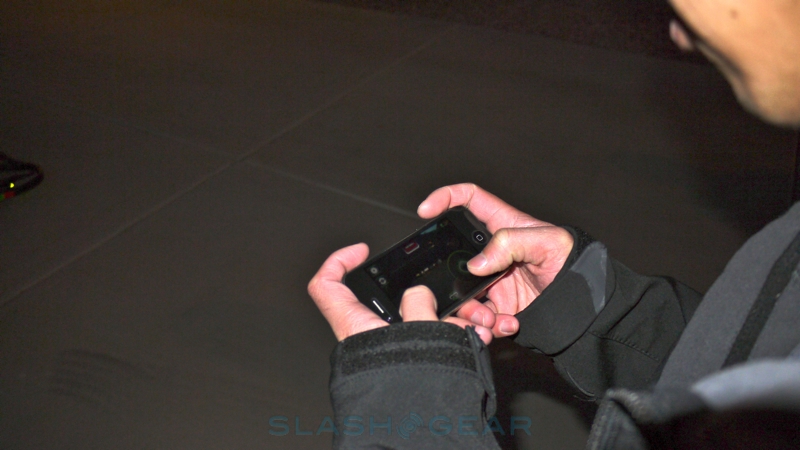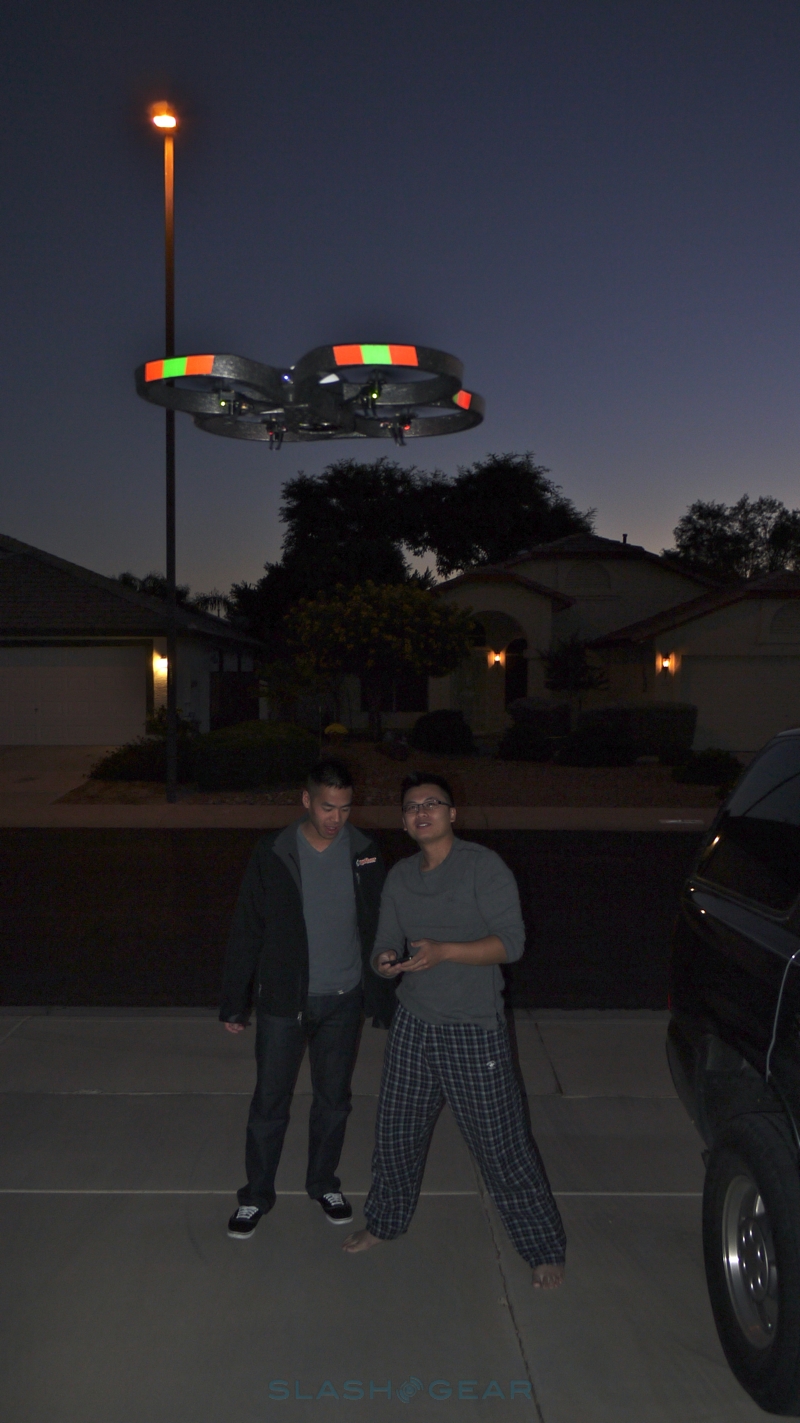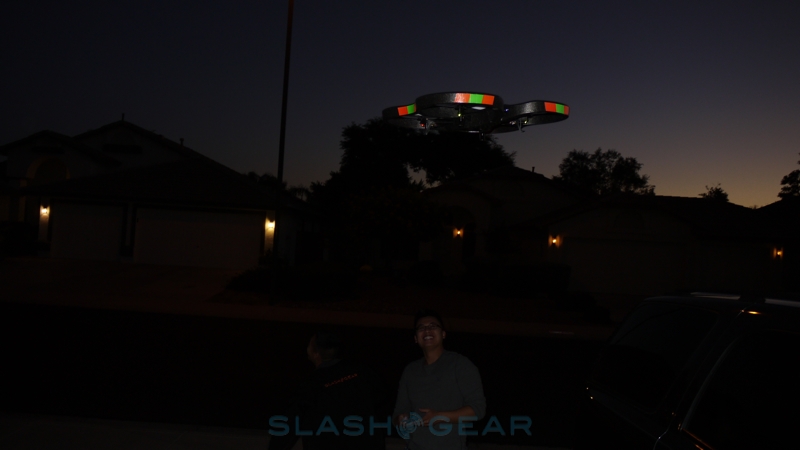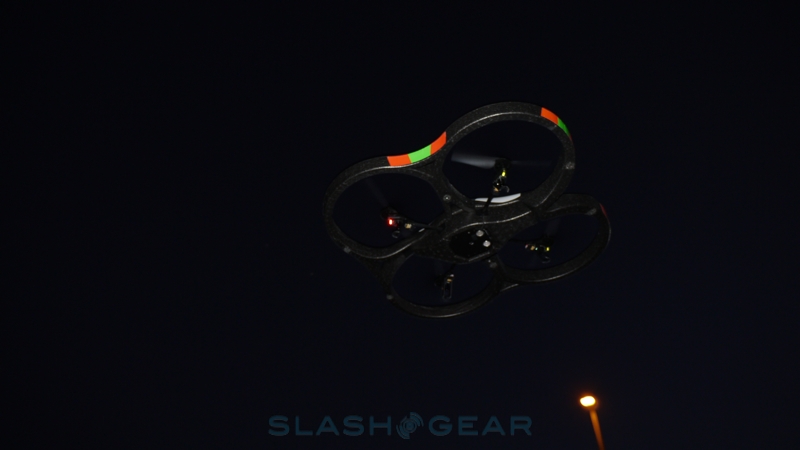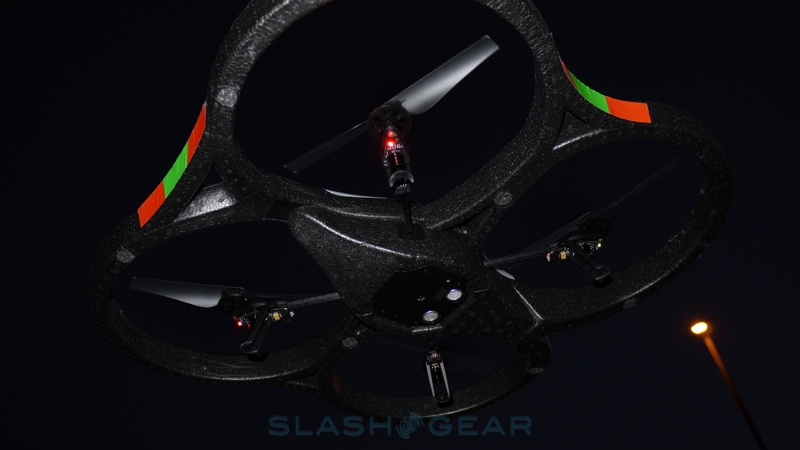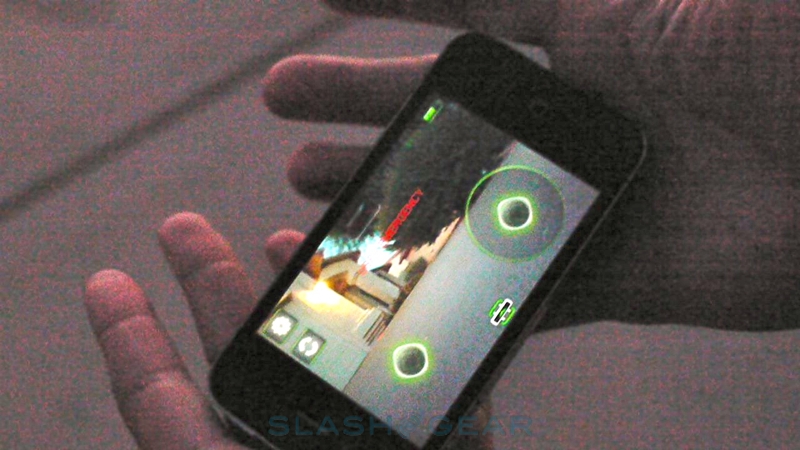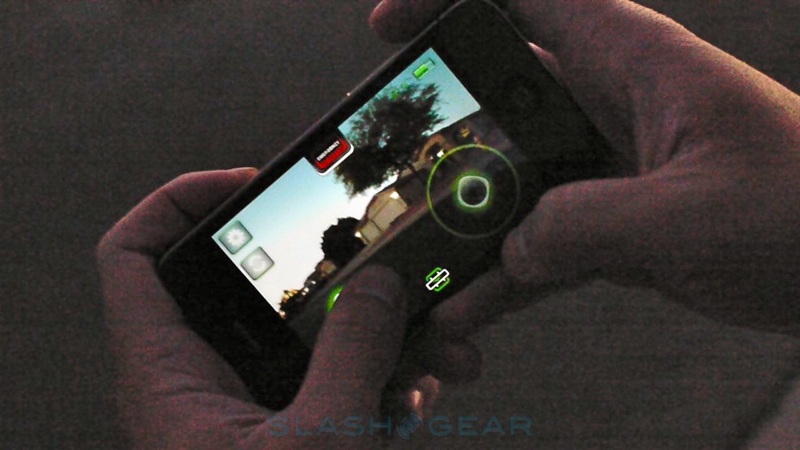Parrot AR.Drone Review
Parrot's AR.Drone was the surprise hit of CES 2010, breaking the French company out of its Bluetooth prison and instead taking to the skies with an iPhone-controlled quadricopter. Reminiscent of something out of a William Gibson novel, the AR.Drone promises to best all R/C helicopters before it, with its combination of four-rotor stability and onboard autopilot intelligence. Check out the full SlashGear review after the cut.
Hardware
While remote-control helicopters have long been using dual, contra-rotating blades for increased stability and easier amateur piloting, the AR.Drone goes even better and doubles that to a full four rotors. They're set on short arms around a black polystyrene hub, into which slots the battery pack. Unlike with many "toy" 'copters, Parrot expects the AR.Drone to be used indoors and out, and provides not only a colorful top chassis but also a removable four-hoop bumper. Indoors, the bumper reduces the likelihood of rotors snapping when you inevitably hit the walls, ceiling and floor; outdoors, the AR.Drone is faster, more maneuverable and more wind-resilient with the bumper taken off.
Inside the AR.Drone there are the same sort of sensors, radios and cameras, as you'd find in a modern smartphone, only here they're all working together to keep the quadricopter airborne. As well as gyroscopes, ultrasound sensors and the like, to keep the 'copter level, Parrot's engineers have used twin cameras to track height and position. One camera points ahead, beaming back a live stream to whichever iOS device you're using to control the AR.Drone, while a second looks down at the ground and is used to monitor speed. Together, they're good enough to keep the AR.Drone hovering stable at a preset height – you can even nudge it with your hand and it will re-steady itself – which means that should you lose controller connection or generally screw up your piloting duties, the Parrot can righten itself automatically.
The final key ingredient is WiFi, which Parrot use to hook up your iPhone, iPod touch or iPad with the AR.Drone itself. Rather than rely on a third-party router – generally in short supply when you're in a park – the AR.Drone creates its own WiFi network to which the iOS app connects (though you have to set up the WiFi permissions in iOS' own Settings pages). Range is a quoted 160 feet – less if there are walls in-between, naturally – and if the AR.Drone does get away from you it'll automatically land when it spots the connection has dropped.
Parrot's choice of plastics, foams and other materials are suitably rugged, and despite repeated crashes as we gradually earned our pilot's stripes we never managed to put more than a minor dent into the chassis. Happily Parrot also make various spares available (for instance, an indoor hull is $30 while an outdoor hull is $20), so if you do manage to snap a rotor you needn't buy a whole new AR.Drone to replace it. As for safety, the blades automatically stop as soon as they encounter any resistance: we jammed a sacrificial SlashGear finger in their way, and escaped scratch-free.
Software
No small amount of the AR.Drone's appeal is its method of control, with Parrot bypassing plasticky remotes and instead heading straight for Apple's App Store. The free software turns an iPhone, iPod touch or iPad into a touchscreen controller, with simple on-screen buttons, a live video feed from either of the two cameras, and accelerometer-led flying.
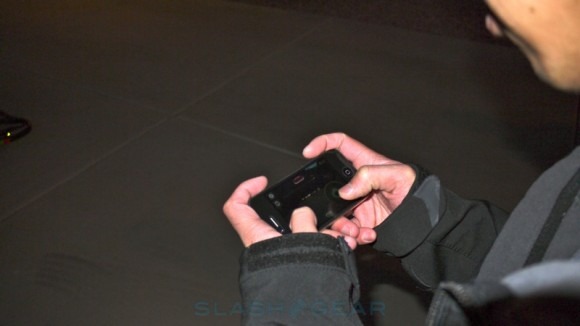
Piloting the AR.Drone requires a combination of screen taps and device movement: physically tilting the iPhone moves the quadricopter forward, back, left and right, while the right thumb controls altitude and rotation with an on-screen joystick. Parrot has sensibly offered two modes, depending on pilot aptitude: the "beginner" mode is less responsive to sudden movements but more forgiving of novice users, while the "ace" mode tightens up the responsiveness if you have the skill level to match. Take your left thumb off the screen and the 'copter automatically hovers.
Colored LEDs on the AR.Drone itself help you figure out its orientation, useful considering it can be otherwise tricky to differentiate which is the front; alternatively you can be brave and attempt to navigate solely from the video feed. This is a reasonably tricky prospect, however, what with the 15fps refresh rate – which Parrot claims is a limitation of the WiFi connection and 640 x 480 resolution – though it does mean you can control the AR.Drone from a completely different room. Unfortunately there's no way to record the streaming video, so you can't, say, strafe your family and then upload the havoc to YouTube. Screenshots via the usual home/power-button iOS combo do work, however. The bottom camera runs at just 176 x 144, but streams at 60fps.
The other notable controls are the auto-land and emergency buttons; the functionality of each is pretty obvious. Auto-land causes the AR.Drone to ease its way to the ground and then kill the rotors; the emergency button, meanwhile, cuts power instantly. Signal strength and power are shown as gauges in the top left and right hand corners, respectively, while the setting pages allow you to tweak responsiveness and re-calibrate the auto-leveling.
While users are expected to get no small amount of enjoyment with a single AR.Drone, Parrot is also hoping that owners will get together and play games with more than one unit. The "AR" in the name stands for "augmented reality", which basically involves running games on the iPhone or iPod touch that overlay graphics onto the view from the AR.Drone's camera. So, with two units you can hold in-air dogfights, trying to line up and blast your opponent on-screen. Each quadricopter identifies the other using the different colored stickers included in the box, and you can have three sets of colors in play at any one time.
Parrot is promising more apps that take advantage of the augmented reality aspect of the AR.Drone – they launched another earlier this month – but their real ambition is to get third-party developers involved. There's an open SDK available, though so far we're yet to see any significant results from it; it may well be a case of coders waiting for the AR.Drone to pick up in sales popularity before they dive in.
As for non-iOS devices, right now there's no way to get involved: the AR.Drone is Apple-only. Back at CES in January 2010 there was talk of an Android version of the controller software, but that's so far failed to materialize. Still, Parrot claims to be adding the communication source code to their development platform, so it's possible a third-party developer could come up with an Android app.
AR.Drone taking flight
Performance
Parrot's control system takes a little getting used to, as does figuring out which way the AR.Drone is facing, but after a short acclimatization period it's clear this is one of the most easily piloted R/C 'copters we've tested. It certainly benefits from having plenty of space, however; the manufacturer recommends 12 x 12 feet for indoor flight. More enclosed spaces can lead to the autopilot system being overwhelmed by air from the rotors buffeting against walls.
Outdoors and that concern is gone, though then you have wind to contend with. The AR.Drone can withstand a moderate wind, but anything above around 7MPH is considered no-go by Parrot, and considering watching $300 worth of quadricopter blown away into the distance will have an unpleasant impact on your wallet, we tend to agree.
The biggest frustration – like with all remote control vehicles – is battery life. Parrot estimate an average flight time of 12 minutes from a full charge, with the battery taking 90 minutes to rejuice. Unfortunately there's only a single power pack in the box, though Parrot will sell you spares at $30 each. In practical terms, we found we were unlikely to fly the AR.Drone solidly, and so the amount of use from a single battery was longer – or at least felt that way – than the stated time. The 'copter also varies in its power demands depending on how you're using it: leave it hovering on autopilot, for instance, and it'll last longer than if you're actively flying it.
Still, it's the biggest stumbling block the AR.Drone faces, and it puts a dampener on the user experience overall. Parrot could have easily gone some way to addressing this by bundling a second battery, which seems a miserly omission.
Wrap-Up
Although Parrot's augmented reality dogfight ideas certainly have merit, they're not the winning feature of the AR.Drone. The units themselves are simply too expensive – and thus rare – to make it likely you'll come across another owner, which means you either need to double your outlay and buy two AR.Drones or content yourself with solo flight. Hopefully third-party developers will bring out games that allow a single user to take advantage of AR gameplay.
Instead, the AR.Drone stands out as the most consumer-ready R/C device we've played with, comfortably ahead of regular – albeit generally cheaper – toy helicopters. Though we wouldn't argue with longer runtime or smoother video, they're both limitations it would likely cost significantly more to address in any meaningful way, and with its $300 sticker the AR.Drone isn't exactly budget-minded in the first place. Having to buy an iOS device if you haven't already got one throws in another hurdle.
The AR.Drone is an expensive toy, certainly, but it's an appealing one, with enough geeky kudos to endear it to adults and children alike. The tipping point will be when – if – third-party developers pick up Parrot's SDK in any significant way, and the quality of the applications they develop. If the AR.Drone can make a good case for augmented reality gaming, that should give the quadricopter a much-needed push further out of the toy-gimmick category.


